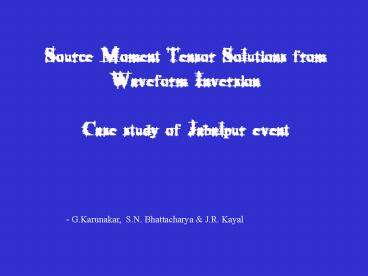Source Moment Tensor Solutions from Waveform Inversion - PowerPoint PPT Presentation
1 / 26
Title:
Source Moment Tensor Solutions from Waveform Inversion
Description:
T-Axis: Azimuth: 269.60 Plunge: 14.70. P-Axis: Azimuth: 190.12 Plunge: 30.46. B-Axis: Azimuth: 7.11 Plunge: 26.50. Seismic moment = 1.440 x 1020 dyne cm ... – PowerPoint PPT presentation
Number of Views:612
Avg rating:3.0/5.0
Title: Source Moment Tensor Solutions from Waveform Inversion
1
Source Moment Tensor Solutions from Waveform
Inversion Case study of Jabalpur event
- G.Karunakar, S.N. Bhattacharya J.R. Kayal
2
Seismogram
Epicentral Distance (?)
Receiver
Vp4.55 km/s Vs2.55 km/s density 2.6 g/cm3
Source Depth (d)
Vp4.55 km/s Vs2.55 km/s density 3.2 g/cm3
Source
- A Seismogram is a result of Source,
propagation path and - seismograph response
- It is possible to generate this
mathematically (Synthetic - Seismogram)
3
A seismogram or a ground motion at a site can be
represented as u(t)
(1)
(2)
U(?) M(?) E(?,?)
(3)
Response
Fourier Transform of source time function m(t) or
moment function
(4)
U(?) M(?) E(?,?) H(w)
Instrument Response
4
For a shear dislocation in an earthquake is a
linear combination of 3 basic fundamental
mechanisms for vertical and radial components and
a linear combination of 2 basic fundamental
mechanisms for Transverse component
Seismogram function
uV(?,t) M0 a uVDD(?,t) b uVDS(?,t) c
uVSS(?,t) uR(?,t) M0 a uRDD(?,t) b
uRDS(?,t) c uRSS(?,t) uT(?,t) M0 a?
uTDS(?,t) b? uTSS(?,t)
(5)
a sin ? sin 2? b - cos ? cos ? cos ?
sin ? cos 2? sin ? c 0.5 sin ? sin 2? cos
2? cos ? sin ? sin 2?
Nonlinear functions of ?, ? ?
(6)
a? sin ? cos 2? cos ? cos ? cos ? sin
? b? cos ? sin ? cos 2? - 0.5 sin ? sin 2? sin
2?
0 ? ? ? 2?, 0 ? ?? ?/2,
-? ? ? ? ?
5
Source function
(7)
m(t) M0 s(t) M0 seismic moment ?s A
D, ?s modulus of rigidity at the source A
area of the fault, D average slip
(displacement) of the rock
above the fault
M(?) M0 S(?)
(8)
- A general source is represented by a moment
tensor M - with six independent elements
- However, in most tectonic earthquakes, there
is no volume - change at the source and thus we have
only five independent - elements of M
6
Moment tensor We define a force couple Mij in a
Cartesian co-ordinate system as a pair opposite
forces (fi) pointing in the i direction,
separated by a distance dj in the j direction.
The magnitude of Mij is given by
There are 9 elements of
Mij. However, the condition that angular
momentum be conserved requires that Mij Mji.
Thus the moment tensor M is symmetric and has 6
independent elements. M
7
The earthquake source is generally deviatoric so
that Mzz - (Mxx Myy) and we have 5
distinct moment tensor components uV(?,t) Mxx
GxxV Myy GyyV Mxy GxyV Mxz GxzV Myz
GyzV uR(?,t) Mxx GxxR Myy GyyR Mxy GxyR
Mxz GxzR Myz GyzR uT(?,t) Mxx GxxT Myy
GyyT Mxy GxyT Mxz GxzT Myz GyzT
G m
8
Greens functions
Greens functions Gij are the ground motion or
synthetic seismogram for the moment tensor
element Mij.
Vertical
Radial
Same equation for Radial component
Transv.
9
Waveform Inversion
- Comparision of Synthetic and Observed
Seismogram - Differences between them are minimised by
adjusting - earth structure and/or source
representation
Suppose the observed displacement component at
the station d(t) the synthetic component
computed u(t)
d(t) u(t) d G
m This equation is solved by least square
inversion method or by
Single Value Decomposition
G-g V ?-1 UT where
singular value decomposition of G is
G U ? VT
10
Case study Jabalpur 2003 event
Date OT P Arrival
S Arrival Lat Long Mag
Depth UTC 21/05/2003
103627.6 103635 103640 22.96
80.10 2.8 ??
Jabalpur station coordinates 23.8760
79.8760
Instrument Parameters of broadband digital system
at Jabalpur
11
(No Transcript)
12
( Kayal, 2000 JGS )
13
BA Map
14
40km UP Map
15
Depth
MULTILAYERED MODEL PARAMETERS
0.000
2.6300
2.400
400.0 200.0
4.5500
2.500
2.600
3.4300
320.0 320.0
5.9400
20.500
6.6500
3.8400
240.0 120.0
3.010
39.000
8.1900
3.300
160.0 080.0
4.7300
70.000
4.9090
100.0 050.0
8.5000
3.500
16
Vertical
2003 event
Radial
Transverse
17
Processing of Observed data
V
T
R
Offset correction (Removal of mean) Rotation for
angle of radial direction Instrument response
removal (In frequency domain) Cosine tapering
(Back to Time Domain) Filtering at 1 Hz
18
Observed Seismogram
Vertical
Radial
Transverse
VP
VS
RP
RS
TS
19
Synthetic Seismogram
Strike Slip
VSS
Vertical
Dip Slip
VDS
CLVD
VDD
Compensated Linear Vector Dipole
RSS
Radial
RDS
RDD
TSS
Transverse
TDS
TDD
20
V
R
T
Synthetic Seismogram
21
Observed
G1
G2
G3
G4
G5
Synthetic
22
Waveform Inversion
23
Fault Plane Solution
Seismic moment 1.440 x 1020 dyne cm
Percentage of double couple 90.8316
Eigen values (1020 Dyne cm) ? 1 -1.405 ? 2
-6.7500E-02 ? 3 1.472
Nodal Planes NP1 ? 82.18 ? 140.30
? -150.03 NP2 ?
60.33 ? 45.82 ? -9.00 T, P
B Axis of the lower Hemisphere of best
DC T-Axis Azimuth 269.60 Plunge
14.70 P-Axis Azimuth 190.12
Plunge 30.46 B-Axis Azimuth 7.11
Plunge 26.50
24
Conclusions
- It is a powerful tool for evaluating earth
structure and - kinamatic parameters of the source even
with such small - magnitude events
- Moment tensor inversion based on
decomposition gives - strike, dip and slip angle of the best
double couple solution - Taking this as starting point, a nonlinear
least square - inversion can be performed to refine the
double couple - solution
- These moment tensor solutions are important
for
25
SPIN OFF
With the availability of BB data on
continuous basis, this inversion technique
should be carried out on all such
seismically active areas as a routine to
monitor the seismicactivity (Could be a
precursor)
26
Thank you all































